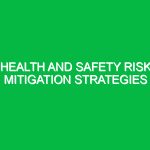In today’s world, many industries operate in extreme environments—places where conditions can challenge even the most experienced professionals. Whether working in blistering heat on an oil rig or braving icy temperatures on a construction site in the Arctic, understanding and implementing safe practices is not just a regulatory requirement; it’s a matter of life and death. This article explores the critical aspects of safe practices for working in extreme environments, focusing on health, safety, and environmental (HSE) considerations. By delving into potential hazards, effective safety precautions, and relevant regulations, we aim to equip workers and managers alike with vital knowledge and insights.
Understanding Extreme Environments
Extreme environments can be characterized by harsh temperatures, high altitudes, intense pressure, or hazardous materials. These include but are not limited to:
- Heat Stress Areas: Locations where temperatures exceed 90°F (32°C), such as foundries or warehouses in summer.
- Cold Stress Environments: Settings with sub-zero temperatures, typical in Arctic expeditions or cold storage facilities.
- High-Altitude Locations: Work sites above 8,000 feet (2,400 meters) where oxygen levels are lower, such as mountaineering or high-rise construction.
- Hazardous Material Zones: Areas where toxic substances are present, including chemical plants or waste disposal sites.
These environments pose unique challenges that require specific knowledge and skills to navigate safely.
Identifying Hazards and Risks
Understanding the array of hazards present in extreme environments is the first step towards formulating effective safety practices. The risks can be broadly categorized into physical, environmental, and chemical hazards.
Physical Hazards
Physical hazards include extreme temperatures, whether hot or cold. For instance, working in high heat can lead to heat exhaustion or heat stroke, while frigid conditions can cause hypothermia or frostbite. A personal experience from a construction manager highlights this: during a particularly hot summer, several workers on a site suffered from heat-related illnesses due to inadequate hydration and rest breaks. This incident underscored the importance of frequent monitoring and intervention.
Environmental Hazards
Environmental hazards often arise from natural elements. High winds can lead to falling objects, while heavy rain can cause slippery surfaces. For example, during a road construction project in a mountainous region, sudden rainstorms triggered landslides, risking the lives of workers. Awareness of weather patterns and timely communication can mitigate such risks.
Chemical Hazards
Exposure to hazardous materials can have severe long-term health effects. Workers in chemical plants may encounter substances that can cause burns, respiratory issues, or even cancer. A case study from a chemical manufacturing facility showcases the importance of proper training and personal protective equipment (PPE). After an incident where a worker suffered chemical burns due to a lack of appropriate gear, the company revamped its safety protocols, leading to a significant decrease in similar occurrences.
Safety Precautions and Best Practices
Implementing safety measures is crucial for minimizing the risks associated with extreme environments. Here are several best practices for working safely in such settings:
1. Training and Education
Proper training is the cornerstone of safety. Employees must receive comprehensive training tailored to the specific hazards of their work environment. This includes understanding the signs of heat stress, knowing how to recognize frostbite, and being aware of the symptoms of altitude sickness. Regular refreshers and drills can keep this knowledge fresh and relevant.
2. Monitoring and Assessment
Continuous monitoring of the environment and worker health is essential. For instance, utilizing thermal imaging cameras can help detect hot spots on equipment, while wearable technology can track body temperature and heart rate in real-time, alerting workers to potential heat stress before it escalates.
3. Personal Protective Equipment (PPE)
Using the right PPE is non-negotiable. For hot environments, this could mean lightweight, breathable clothing, while cold environments demand insulated, moisture-wicking layers. A story from an oil platform illustrates this: after a worker suffered severe burns from hot oil due to insufficient protective gear, the company mandated the use of specific PPE, significantly reducing incidents.
4. Hydration and Nutrition
In extreme heat, hydration is vital. Workers should have access to cool water and electrolyte-replenishing drinks. In cold conditions, maintaining energy levels with high-calorie foods can combat fatigue and hypothermia. A logistics manager once noted that instituting mandatory breaks for hydration and snacks during a heatwave led to a marked decrease in heat-related illnesses on the job site.
5. Emergency Preparedness
Having a robust emergency response plan is critical. This includes training workers on evacuation routes, establishing first-aid stations, and conducting regular emergency drills. For instance, a mining company that regularly practiced emergency evacuation procedures managed to evacuate workers swiftly during a gas leak, avoiding potential disaster.
Relevant Regulations and Standards
Several regulations guide safe practices in extreme environments. These include:
- Occupational Safety and Health Administration (OSHA): OSHA sets forth regulations regarding worker safety in hazardous environments, including specific guidelines for heat and cold stress.
- National Institute for Occupational Safety and Health (NIOSH): NIOSH provides research and recommendations for preventing workplace illnesses and injuries, particularly in extreme conditions.
- American National Standards Institute (ANSI): ANSI outlines standards for personal protective equipment, ensuring materials meet safety requirements.
Adhering to these regulations is more than just compliance; it fosters a culture of safety and accountability within the organization.
Conclusion
Safe practices for working in extreme environments are essential for protecting workers’ health and well-being. By understanding the unique hazards presented, implementing effective safety precautions, and staying informed about relevant regulations, organizations can create a safer workplace. As the construction manager I mentioned earlier learned, prioritizing safety is not just beneficial—it’s imperative. In extreme environments, every precaution taken can mean the difference between life and death. As industries continue to evolve and explore more challenging environments, a steadfast commitment to safety will remain a critical component of success in the HSE domain.


